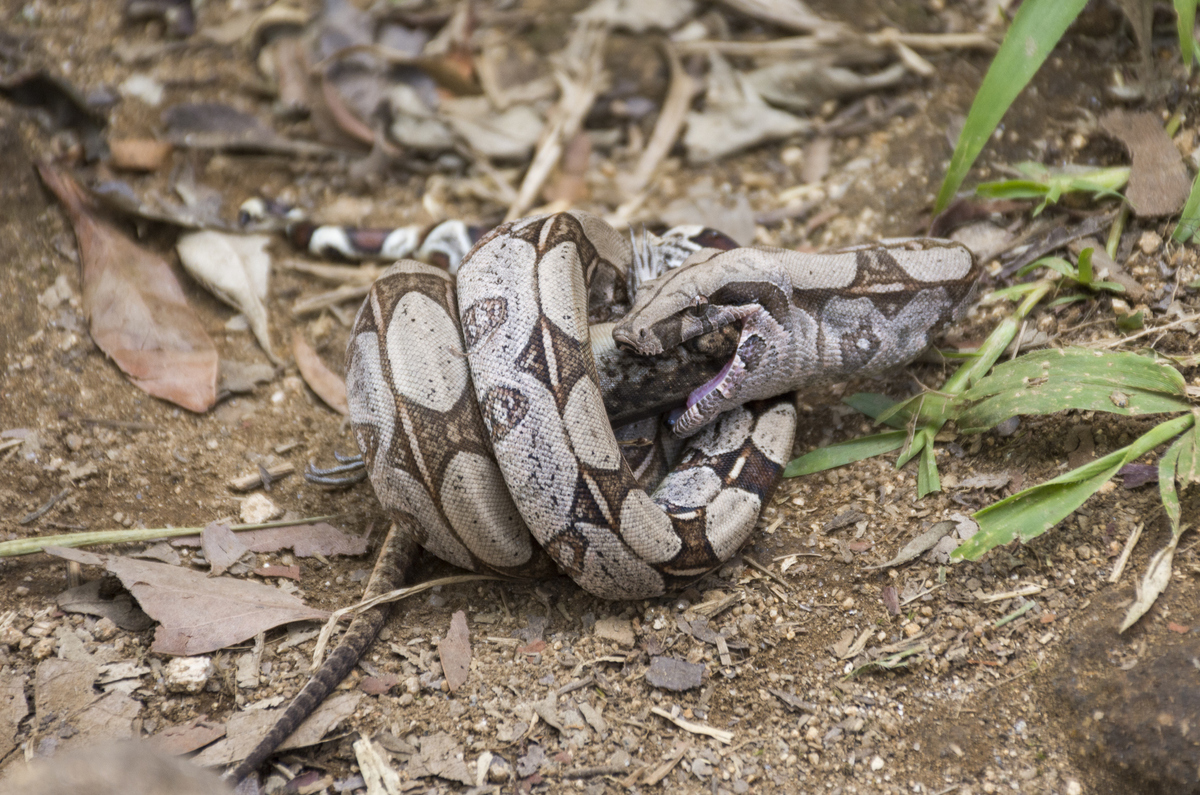[ad_1]

A boa constrictor feeds on a lizard in Tijuca Forest National Park, Rio de Janeiro, Brazil.
Vitor Marigo / Aurora Photos/Getty Images/Aurora Open
hide caption
toggle caption
Vitor Marigo / Aurora Photos/Getty Images/Aurora Open

A boa constrictor feeds on a lizard in Tijuca Forest National Park, Rio de Janeiro, Brazil.
Vitor Marigo / Aurora Photos/Getty Images/Aurora Open
Snakes that constrict and then swallow enormous prey have evolved a way to keep themselves from suffocating while they do it.
When the scaley coils closest to the snake’s head are super busy squeezing its dinner to death, the reptile can simply change how it breathes so that it uses ribs and muscles farther down the length of its body.
That’s according to a new study that used an inflated blood pressure cuff to immobilize different parts of boa constrictors’ bodies while simultaneously doing X-ray scans to monitor their ribs’ movement. What researchers observed is that the snakes could easily shift to using different sets of ribs to draw in air like a bellows.
“I just found it remarkable that they had such fine control,” says the study’s author John Capano, who studies biomechanics at Brown University. “We see just particular regions of ribs get activated and other regions are completely quiet and don’t move.”
A discovery with a tiny helmet and a blood pressure cuff
Boa constrictors have more than two hundred pairs of ribs running down the length of their bodies, and normally breathe by using muscles to rotate their rigid rib bones and pump air in and out.
Like the rest of their bodies, the lungs of a snake are long and stretch down much of the snake’s length. The part of the lungs closest to the head is where gas exchange seems to take place, as it is rich in blood vessels, while the part of the lungs closer to the snake’s tail is more like an empty bag.
When a snake bites and grabs prey, the front part of its body is usually completely engaged in subduing the meal by constricting it. And then, once a snake starts to ingest what is often a large animal relative to its own size, the rib cage has to spread wide open. “There’s a chance that they can’t move their ribs anymore, because they’re already at capacity,” says Capano.
A while back, when he was working in the lab of Scott Boback at Dickinson College, Capano and Boback noticed that when they fed snakes, “it looked like they were breathing with another section of the body” than what you’d see when they were “just kind of hanging out on the table at rest,” Capano recalls.
But it wasn’t clear whether this represented a true change in breathing on the snakes’ part. Perhaps, the snakes were always trying to move the same ribs in order to breathe, but the physical demands involved in squeezing and swallowing prey just kept some ribs from being able to do it?
“That was sort of the beginning of the project, can they control this?” says Capano.
In the Journal of Experimental Biology, Capano and a team of researchers describe how they put blood pressure cuffs on different parts of snakes’ bodies to basically prevent the ribs from moving. “We put like a little tiny helmet on the snake that lets us measure air flow in and out of it, so we could measure that it was breathing,” says Capano. The team used X-rays to watch bone movement inside the snake, and also monitored nerve signals.
When they put the cuff on the front section of snakes, the animals would switch to breathing with a set of ribs back towards the tail. “And if you take the cuff off, they stop moving in the back, and they go back to the front,” says Capano.
Because the ribs at the far end of the snake only got involved when the front section was unable to move, Capano says it appears that the bag-like section of lung at the rear of the snake essentially operates like a bellows to draw air through the section of lung at the front of the snake where gas exchange occurs.
A key to evolutionary success?
“They very convincingly show that the snake has control over where it is ventilating along the trunk,” says Jake Socha, a researcher who studies animal biomechanics at Virginia Tech University. “This is a really key, important study in helping to explain what might have made snakes so successful.”
After all, thousands of snake species thrive in environments ranging from the ground to trees to the ocean to even the air (in the case of flying snakes). The long, limbless body has proven extraordinarily adaptive, in part because snakes evolved ways of killing relatively big animals, giving them more prey options to exploit.
“Snakes evolved constriction to do this, and so our idea is that there had to be some respiratory innovations that went along with that,” says Elizabeth Brainerd, a biomechanics researcher at Brown University. “As constriction was evolving, it was certainly impeding the ability of those animals to use the ribs in that area for breathing. And so there would have been pressure to evolve this modular breathing, to move breathing to a different part of the ribcage.”
Brainerd has long been fascinated by how the mechanics for pumping air in and out of the lungs vary between animals. “Breathing is something that we hardly ever think about but really is a biomechanical problem,” she says.
And while humans have an entirely different breathing setup from snakes, including a diaphragm and a breast bone that snakes don’t have, Brainerd can’t help but notice that people have a couple of more snake-like “floating ribs” that don’t attach to anything in the front.
“Now I’m really interested in the extent to which we control those floating ribs separately, and under what conditions we do,” says Brainerd.
[ad_2]
Source link



